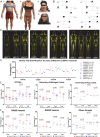Potential Impact of Parental Origin of Inheritance on the Clinical Presentation of Familial Partial Lipodystrophy Type 2 Syndrome
- PMID: 40671313
- PMCID: PMC12413679
- DOI: 10.1111/cen.15303
Potential Impact of Parental Origin of Inheritance on the Clinical Presentation of Familial Partial Lipodystrophy Type 2 Syndrome
Abstract
Context: Familial partial lipodystrophy type 2 (FPLD2) is a rare autosomal dominant disorder caused by pathogenic variants in the LMNA gene. The influence of parental inheritance on clinical presentation has not been fully explored.
Objective: To investigate the influence of maternal versus paternal inheritance of LMNA variants on the clinical and metabolic phenotype of patients with FPLD2.
Design, patients, measurements: This retrospective cohort study included 83 patients with FPLD2 from four different centres. Clinical, biochemical, and body composition data were analysed. Patients were grouped based on maternal (maternal inheritance group; n = 49) or paternal (paternal inheritance group; n = 34) inheritance of LMNA variants. Statistical comparisons were made between the groups.
Results: Patients in the maternal inheritance group had a younger current age (35 (33) vs. 48 (22) years, p = 0.042) and earlier diagnosis of lipodystrophy (22 (30) vs. 36 (25) years, p = 0.044) compared to those in the paternal inheritance group. Body fat percentages in the arms (23.8 (6.5) % vs. 21.0 (6.2) %, p = 0.034) and trunk (32.1 (10.3) % vs. 28.5 (6.1) %, p = 0.024) were higher in maternal inheritance group. Fatty liver disease (79% vs. 57%, p = 0.029) and pancreatitis (26% vs. 8%, p = 0.033) were more prevalent in paternal inheritance group.
Conclusion: Parental lineage may influence the phenotype of FPLD2: patients with a maternally inherited LMNA variant tend to preserve more adipose tissue in the upper body, while those with a paternally inherited variant experience greater adipose tissue loss in that region, often associated with more severe metabolic complications. These findings highlight the importance of contemplating parental lineage as a relevant factor when evaluating the clinical presentation and management of patients with FPLD2.
Keywords: LMNA; body composition; dual X‐ray absorptiometry; fat mass; lean mass; parent‐of‐origin effect; partial lipodystrophy.
© 2025 The Author(s). Clinical Endocrinology published by John Wiley & Sons Ltd.
Conflict of interest statement
E.A.O. is the inventor of a method‐of‐use patent for 'metreleptin in the treatment of lipoatrophy, lipodystrophy, lipoatrophic diabetes, and related conditions'. She has received consultancy fees from Amryt Pharmaceuticals and Chiesi (formerly Aegerion Pharmaceuticals). E.A.O. has served as a consultant to Ionis Pharmaceuticals, Rhythm Pharmaceuticals, and Regeneron Pharmaceuticals through payments made to the University of Michigan and currently receives grant support from all three companies. She also has ongoing clinical trial contracts with Morphic Medical (formerly GI Dynamics), Fractyl, and Novo Nordisk. In addition, E.A.O. has received personal consulting fees from Third Rock Ventures and Amryt Pharmaceuticals and serves on the Scientific Advisory Board of Rejuvenate Bio. B.A. has run projects for and/or served as a consultant, board member, steering committee member, and/or speaker to Amryt Pharmaceuticals (wholly owned subsidiary of Chiesi Farmaceutici S.p.A.), Alnylam, Regeneron, ThirdRock Ventures, AstraZeneca, Novonordisk, Boehringer Ingelheim, Sanofi, Bilim Ilac, ARIS, and Servier. C.P. received fees for consulting and/or travel funds from Amryt (now Chiesi Farmaceutici). G.C. received fees for consulting and/or travel funds or participated in studies from the following companies: Amryt (now Chiesi Farmaceutici), Novo‐Nordisk, Eli Lilly, and Rhythm Pharmaceuticals. F.S. received a consultancy fee from Amryt (wholly owned subsidiary Chiesi Farmaceutici S.p.A.); has run projects for and/or served as a consultant, board member, steering committee member, and/or speaker for Amryt Pharmaceuticals (wholly owned subsidiary of Chiesi Farmaceutici S.p.A.), Novonordisk, Ingelheim, Eli Lilly, Pfizer, Bruno Farmaceutici, and Bioltalia. N.R.G. has served as an Advisory Board Member for PTC Therapeutics and Amryt/Chiesi; participated as a speaker for Novo Nordisk, the BI‐Lilly Alliance, Amryt/Chiesi, and PTC Therapeutics; and attended congresses and scientific events sponsored by Novo Nordisk, Lilly, PTC Therapeutics, Amryt/Chiesi, and Servier. J.V.S. has received speaker and consulting fees from Amryt/Chiesi Pharmaceuticals and Rhythm Pharmaceuticals. The remaining authors report no conflicts of interest.
Figures

References
-
- Garg A. and Garg A., “Gender Differences in the Prevalence of Metabolic Complications in Familial Partial Lipodystrophy (Dunnigan Variety),” Journal of Clinical Endocrinology & Metabolism 85, no. 5 (2000): 1776–1782. - PubMed
MeSH terms
Substances
Grants and funding
LinkOut - more resources
Full Text Sources
Miscellaneous

